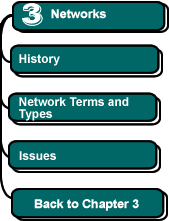

|
Chapter 3: Computer Networks and the Internet
The concepts and ideas with which you should be familiar are contained in the chapter 3 checklist. Print out the checklist to use as a study/notes guide while working through the chapter.
| "The network is the computer." Bill Joy, Sun Microsystems |
As we have seen, for much of the history of information technology, computers were big, expensive, and few and far between. This had several implications:
- Computers
usually had to be shared
by many users in order to justify the cost and space these systems required.
Thus, unlike today's personal computers, in which one person uses a
computer at a time, for much of their history computers have been multi-user
(aka time-sharing) systems.

- However,
in order to use a computer, a user had to be local—in
close physical proximity to the machine. Typically, this meant working
at a terminal, a combination of a keyboard and a screen
that is designed to work with a particular brand of computer system.
(Today, we often call these devices dumb terminals
because, unlike personal computers, they do not contain a CPU chip.)
Because there are limits to the length of the wires that can connect
a terminal to a "port" on the computer system itself, truly
remote access was not a possibility for most users.
In time, it was discovered that by using a modem—so called because it is a device that "modulates" (turns binary digits into sounds) and "demodulates" (turns sounds back into binary digits)—an ordinary telephone line could provide a link between a terminal and a computer system. Even so, modems were initially expensive devices, and this fact, along with the cost of long-distance telephone calls, confined most users to local computing.

- Computers were stand-alone machines. They were not connected to other computers—i.e., networked. If users of one computer system wished to share data with another computer system, this typically meant that the data had to be saved onto magnetic tape, and the tape had to be transported to the other computer system (which might be thousands of miles away), where the second computer could read the data on the tape.
![]()
![]()
This chapter was written by Jeff Nyhoff and Joel Adams. Copy editing by
Nancy Zylstra
©2005 Calvin University (formerly Calvin College), All Rights Reserved
If you encounter technical errors, contact computing@calvin.edu.